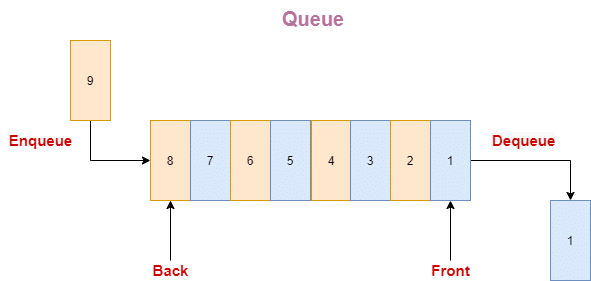

The new element is added at headNode, and its next is set to oldHead. When an element is pushed into a stack, oldHead stores the value of headNode. There is no restriction on the size of Stack as we are using LinkedList. If headNode is null and pop() or peek() operations are performed then it throws an Exception, as the stack is empty. In the constructor method, we initialize headNode to null and stackSize to 0. In LinkedList-based implementation, we create a LinkedList class and declare the head node. Implementation of Stack Using LinkedList in Java Likewise, Stack can also be implemented using LinkedList. Identically, the pop() method also throws EmptyStackException if the stack is empty or removes the top element, returns its value, and decreases topIndex by 1. If the stack is empty, it throws EmptyStackException. The peek() method returns the topmost element in the stack i.e data.
#Java basic data structures queue full
If it is full it throws an Exception else it simply adds an element to the stack and increment the topIndex by 1. The push() method first checks if the stack is full. The empty() method checks if the topIndex is at -1 which implies, the stack is empty. The size() method returns the size of the stack i.e. We initialize the data array and topIndex in the constructor method.


Default Array capacity is 1000 for the stack where capacity is not mentioned. There are two constructor methods, one with capacity customed by the user and the other default. We declare an array named data to store the values and topIndex to keep track of the top element. We can make a stack of String datatype, of Integer datatype, or Character datatype. It enables the user to use any data type. We name our class as ArrayStack as we are using Array to store our data.Į in Angular brackets () makes our class Generic. It will have the same functionality as we saw in the above examples. We are implementing our own stack using class and methods. Implementation of Stack Using Array in Java These operations are also performed using stacks. You must have also observed the Back and Forward buttons on browsers. When you make changes, it pushes changes onto the stack. When you undo something, it pops the most recent action. One such application is the undo mechanism in text editors. No element can be retrieved, removed, or added from the middle of the stack. Likely, elements can be added to the stack at the top, and they can be seen or removed from the top. We cannot add or remove a plate at the middle of the stack. So, when we need a plate, we take (pop) from the top of the stack, and when we want to add a plate, we put (push) it at the top as well.

The name “stack” is derived from a stack of plates.


 0 kommentar(er)
0 kommentar(er)
